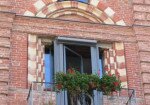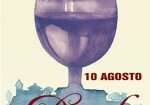
 Beautiful example of Italian Gothic, the Duomo, dedicated to the Assunta and San Gottardo, was realized in the first half of the 14th century on the initiative of Bishop Arnaldo De Rosette.
Beautiful example of Italian Gothic, the Duomo, dedicated to the Assunta and San Gottardo, was realized in the first half of the 14th century on the initiative of Bishop Arnaldo De Rosette.
Having regard to the French religious sources, architectural and decorative patterns of the Church are of that nation, the imposing mole recalls the cathedrals-fortresses of the French MIDI.
In the 18th century Bernardo Vittone deals to extend the building making the sacristies; at the same time are eliminated the ribs of the times and is made the ciborium from the artist Francesco Piffetti. The Campanile It is a Romanesque seniority than half 13th century. Very beautiful patterned Zoomorphic decorations and plants of local tradition of the frontispiece on the South side of the building and the representation of "Mary between angels, Apostles and saints ". The other distinctive element of the emblem Pelletta, posted to mark the contribution made by the family to realize this input.
Notable, then, the sculptural decoration of the main entrance, especially the shelves and the capitellino. The aisles, the transept and cupola are frescoed in the 18th century by Francesco factory and g. Battista Rocca; in the same century the apse frescoes by Carlo Carlono and G. Perego. Many paintings of Gandolfino da Roreto, built between the 15th and the 16th century: Our Lady of the "Banker", The marriage of Madonna, the dismembered Altarpiece of Madonnna genealogy and the deposition. Interesting, in addition, the resurrection of Guglielmo Caccia, detto il Moncalvo (late 16th century., early 17th). The wooden furnishings are by Francesco and Antonio Varale Wage, While the central altar is the work of Benedetto Alfieri. Complete inside the 15th century baptismal font, originally Roman bare material, and two putti resting on Roman capitals: a pre-Romanesque and the other Gothic. Don't miss a polychrome terracotta statue groups representative of the dead Christ in the sixteenth century.
The two bodies of the Church were made one by Grisanti in the 18th century, the Serassi the next century. Interesting marble plaque by Arricino 13th century Coin which represents the first example of Piedmontese equestrian monument. Last work of note the headstone of Bishop Malabayla of 14th century Afuwape.
 Discover the views of the Interior of the Cathedral on the site of the municipality of Asti
Discover the views of the Interior of the Cathedral on the site of the municipality of Asti






 Organ night
Organ night  Asti Musica
Asti Musica  GustaDom and Merca’ d ij Busiard
GustaDom and Merca’ d ij Busiard 


 Do you want to highlight your event or business?
Do you want to highlight your event or business? Alessandra Scotti Web Design Art Director, graphicsdesign, webdesigner
Alessandra Scotti Web Design Art Director, graphicsdesign, webdesigner B&B La Rana e La Salamandra House for rent and Bed & Breakfast in Loazzolo
B&B La Rana e La Salamandra House for rent and Bed & Breakfast in Loazzolo Educational Farm ArteMiele Genuine products and educational workshops to discover bees and silkworms
Educational Farm ArteMiele Genuine products and educational workshops to discover bees and silkworms